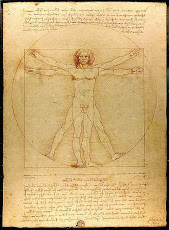Some of the finest examples of this style include the cathedrals of Chartres, Reims and Amiens.
 Magi
Magi Most notable Gothic painters
- Bonaventura Berlinghieri (1215-1242) Italian
- Simone Martini (1285-1344) Italian
- Segna di Buonaventure (1298-1331) Italian
- Altichiero (1330-1384) Italian
Renaissance
Style adopted in Europe in the 15th and 16th centuries, and modelled on classical Greek and Roman styles. Referred to as the “rebirth” of the ideals and values of the classical Greek, Hellenistic and Roman styles. Through this era, the emphasis was more on enjoying their wealth, rather than acquiring and hoarding their wealth. This is one of the most well known eras.
Some of the finest examples of this style include the Mona Lisa, Santa Maria del Fiore, the cathedral of Florence, sculpture of David, Primavera, The Birth of Venus and the ceiling of the Sistine Chapel.

Mona Lisa
Most notable Renaissance painters
- Leonardo da Vinci (1452-1519) Italian
- Michelangelo, (1475-1564) Italian
- Raphael Sanzio (1483-1520) Italian
- Tiziano Vecellio aka Titian (c. 1488-1576) Italian
- Jacopo Tintoretto (1518-1594) Italian
- Paolo Veronese (1528-1588) Italian
Baroque
Extravagant and highly decorative style. It was popular mainly in Catholic European countries from 1600 to 1720. The Roman Catholic Church demanded that sculptures and paintings should speak to the illiterate rather than to the well informed when in church contexts. The arts were to communicate religious themes in direct and emotional involvement, where the visceral appeal aimed at the senses, in order to produce more drama to the paintings.
Some of the finest examples of this style include the St. Theresa in Ecstasy, Ludwigsburg Palace, Palace of Trier, Melk Abbey.
Some of the most renowned and acclaimed Baroque artists were as follows
- Anthony Van Dyck (1599-1641) Flemish
- Paul Rubens (1577-1640) Flemish
- Johannes Vermeer (1632-1675) Dutch
- Claude Lorrain (c. 1600-1682) Italian
- Giovan Baciaccia (1639-1709) Italian
- Agostino Carracci (1557-1602) Italian
Pre-Raphaelite
Highly symbolic style adopted by group of mid 19th century London artists inspired by the brightly coloured pictures produced in Italy before the artist Raphael (1483-1520). A group of seven London artists formed a member “brotherhood”. The Pre-Raphaelites have been considered the first avant-garde movement in art, though also denied this status, due to their continued acceptance of the concepts of history painting and of mimesis (imitation of nature) as the focal point of their art. The group’s intention was to reform art by rejecting the Mannerist artists who followed Raphael and Michelangelo, believing that the elegant compositions and classical poses had a corrupting influence on the teaching of art.
Some of the finest examples of the “brotherhood” were Christ In the House of His Parents by John Everett Millais, Medea by Evelyn De Morgan, The Holy Family by James Collinson, The Hireling Shepherd by William Holman Hunt and Persephone by Dante Gabriel Rossetti.
The seven members of the brotherhood were
- William Holman Hunt (1827-1910) British
- Dante Gabriel Rossetti (1828-1882) British
- John Everett Millais (1829-1896) British
- William Michael Rossetti (1829-1919) British
- James Collinson (1825-1881) British
- Thomas Woolner (1825-1892) British
- Frederic George Stephens (1827-1907) British
Romanticism
Romanticism reached its peak in France in about 1830. The core philosophy behind Romanticism was the idealization of reality with a sensational or sentimental style, often using a mythological theme, characterised by intense emotional excitement and depictions of powerful forces in nature, exotic lifestyles, danger, suffering, and nostalgia, because of this sweeping nature of Romanticism, most critics will tell you that Romanticism was little more than a “feeling”. This in turn redefined the fundamental ways in which people in Western cultures thought about themselves and about their world.
Some of the finest examples of this style were Episode of the Belgian Revolution of 1830, The Raft of the Medusa, Liberty Leading the People 1830, The Third of May 1808.
Some of the most renowned and acclaimed Romantic artists were as follows
- Francisco Goya (1746-1828) Spanish
- Joseph Mallord William Turner (1775-1851) English
- Théodore Géricault (1791-1824) French
- Eugène Delacroix (1798-1863) French
- Thomas Cole (1801-1848) American
- Egide Charles Gustave Wappers (1803-1874) Belgian
Impressionism
Late 19th Century style used largely by French painters, who gathered in a group at the Café Guerbois, to form the Impressionists. The trademark of the impressionist style of painting is the concentration on the general impression produced by a scene or object and the use of unmixed primary colours, open composition and small visible brushstrokes to simulate actual reflected light with the emphasis on light in its changing qualities.
Some of the finest examples of this style were Soleil Levant, Girl with a Hoop, The Cliff at Étretat after the Storm, Auf der Terasse and Haystacks.
Some of the most renowned and acclaimed Impressionistic artists were as follows
- Georges Seurat (1859-1891) French
- Claude Monet (1840-1926) French
- Camille Pissarro (1830-1903) French
- Pierre-Auguste Renoir (1841-1919) French
- Edgar Degas (1834-1917) French





No comments:
Post a Comment